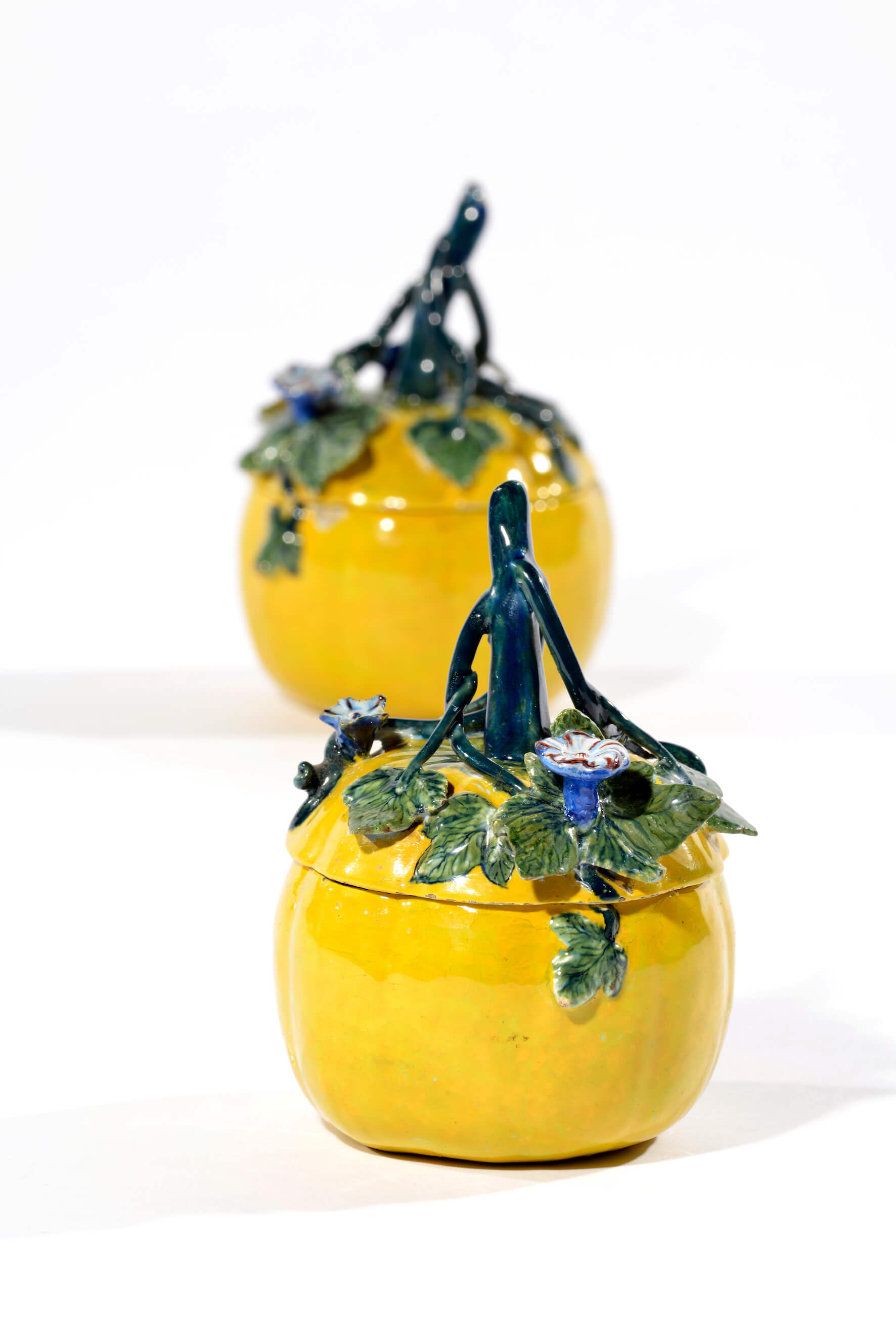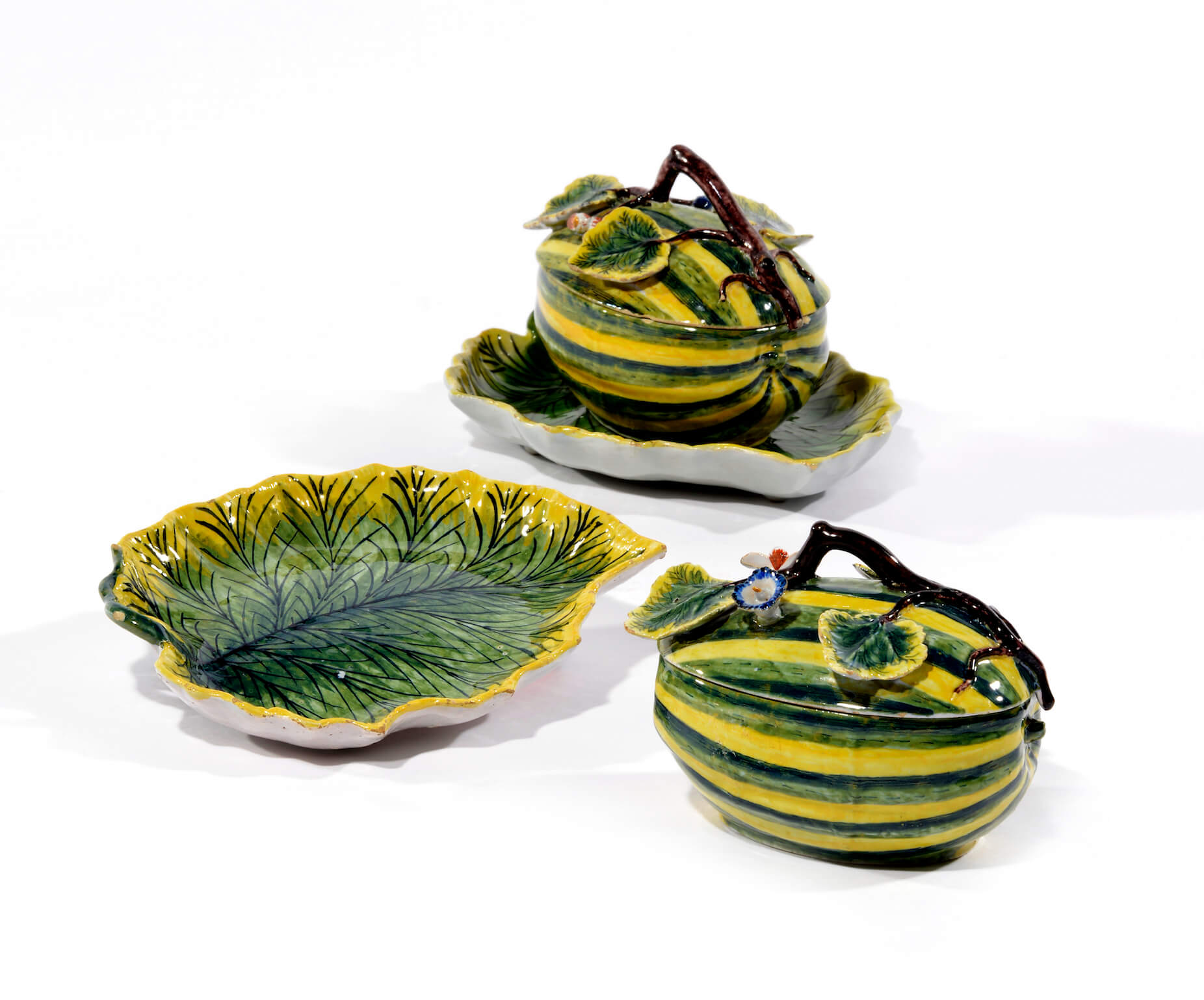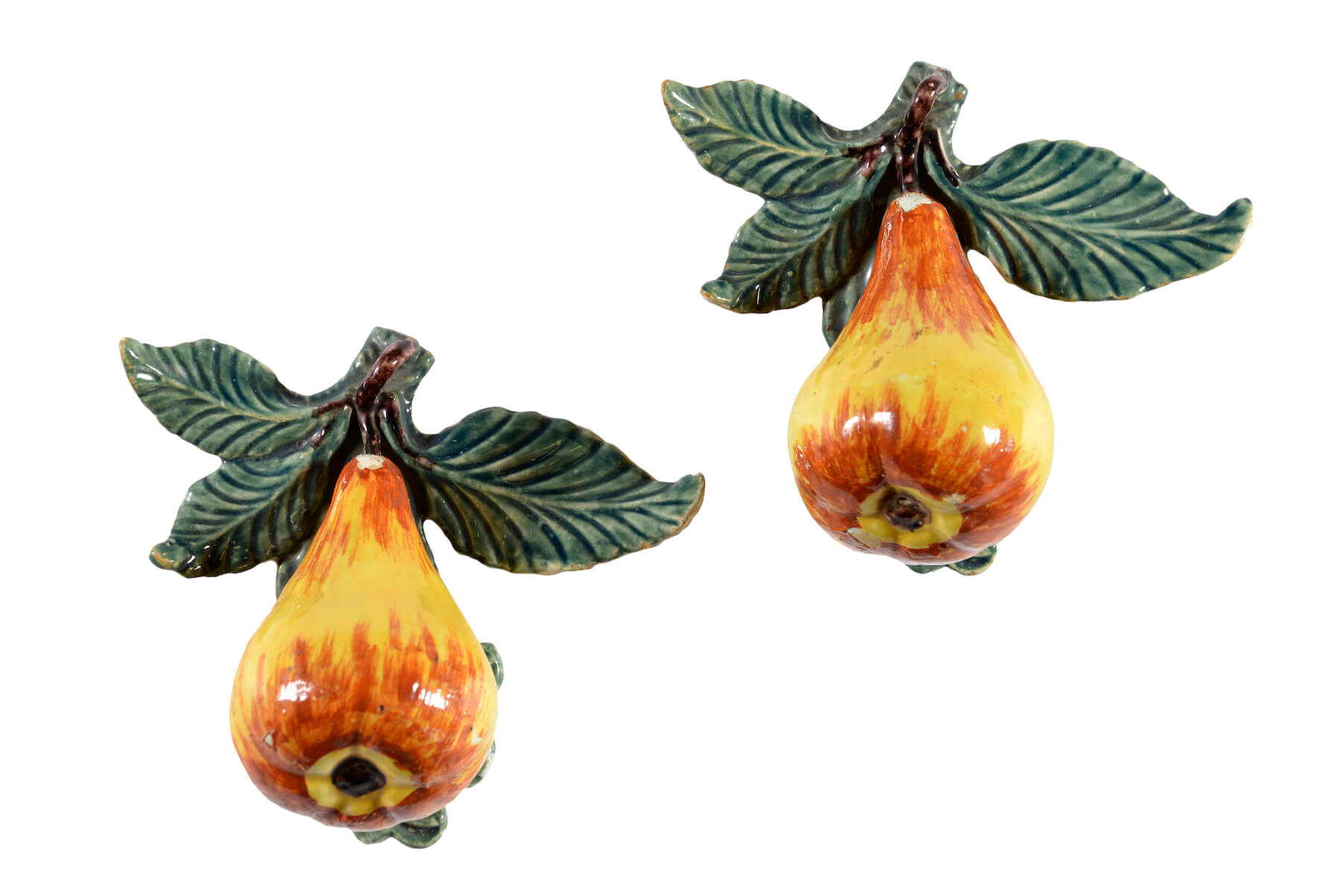
Trompe l’oeil Amusements
Trompe l’oeil, or deceive the eye, was a technique used in both modeling and painting Delftware to captivate and fool the viewer. One of the predominant centers of production of these naturalistic forms was Delft, where the city’s potteries quickly accommodated the new taste of the nobility and the wealthy bourgeoisie for adorning their tables with brightly colored fruits and vegetables, and zoomorphic objects in the form of domestic and exotic animals and birds. The extraordinary realism of the Delft table wares both puzzled and amused guests.[1]
The style is seen most vividly in the Delft serving wares that accompanied the fashionable dining à la Française (in the French manner) that swept through Europe during the eighteenth century. Inspired by the French court of Louis XIV (1638-1715, reigned 1643-1715), guests were served numerous dishes at once during the formal dinner service. A 1790 Housekeeper’s Instructor illustrates that a dinner à la Française included three courses: the first of “soups, boiled poultry, fish and boiled meats,” the second of “different kinds of game, high seasoned dishes, arts, jellies, etc.,” and the third consisted of a dessert course of “fruits, and various kinds of ornamental pastries”.[2]
Tureens, platters, and fruits were designed to complement the various courses (large tureens for soup, stew or ragout, butter dishes; smaller tureens for sauces and creams; and open sweetmeat dishes formed as flowers or leaves). The panoply of wares were symmetrically arranged on the table and within reach for guests to serve themselves. The practice was an opportunity to showcase the culmination of splendor in the meal as well as the elaborate serving wares.
 Large, naturalistically modeled tureens were often the centerpiece of a formal dining service, and provided the potter with endless creative possibilities. Tureens modeled as birds, animals, fruit and vegetables, often with accompanying stands molded with foliage, were produced from circa 1750 in numerous faience and porcelain centers, including Strasbourg and Sceaux in France; Höchst and Meissen in Germany; Chelsea and Longton Hall in England; and most spectacularly in Chinese export porcelain made predominantly for the Iberian market.[3] The origin of these tureens is uncertain, but they probably evolved from polychrome sugar or wax figures and bird-shaped pastries. In certain instances, they may have been created as more permanent and palatable replacements for real-life examples, such as the severed head of a wild boar that represented the trophy of a hunt.[4]
Large, naturalistically modeled tureens were often the centerpiece of a formal dining service, and provided the potter with endless creative possibilities. Tureens modeled as birds, animals, fruit and vegetables, often with accompanying stands molded with foliage, were produced from circa 1750 in numerous faience and porcelain centers, including Strasbourg and Sceaux in France; Höchst and Meissen in Germany; Chelsea and Longton Hall in England; and most spectacularly in Chinese export porcelain made predominantly for the Iberian market.[3] The origin of these tureens is uncertain, but they probably evolved from polychrome sugar or wax figures and bird-shaped pastries. In certain instances, they may have been created as more permanent and palatable replacements for real-life examples, such as the severed head of a wild boar that represented the trophy of a hunt.[4]
This pair of polychrome melon tureens and their accompanying covers and stands were made around 1760. Each lobed oval tureen and cover is striped in yellow and two shades of green. The covers are surmounted by a manganese looped-stem handle issuing three short stems of yellow-edged and blue-veined green leaves, and two stems of iron-red and blue blossoms. The stands are formed as green serrated leaves edged in yellow, veined in blue, and affixed at one end with a green looped-stem handle. The melons and stands are each marked VH 3, and one tureen and cover is numbered 1 on the interior; the other tureen is numbered 14 on the interior.
 Melons were a greatly fancied fruit during the Baroque period, appearing frequently in seventeenth-century Dutch still life paintings. They also were savored as edible delicacies, appreciated for their intense aroma and supple flesh. Medicinal properties were attributed to melons; they were believed to cure fevers and acted as an antidote for inflammations of the kidney, bladder and liver. When served as a dessert, the fruit was chopped into pieces and seasoned with sugar or salt and pepper. A special delicacy was a tart of melon-pieces covered in a pastry-crust and baked in butter. These delicacies were amusingly presented in matching faience tureens such as this pair of polychrome melon tureens, made around 1760. They are formed as a yellow lobed spherical fruit, with a cover surmounted by a tall green stalk and three green stems. Entwined stems of blue, iron-red and manganese-striped blossoms and green leaves are delicately molded to the tureen. These matching faience tureens were intended mainly for the dessert course at the end of a meal when fruits, creams, and various pastries were served. The culinary pleasure of these delicacies could only have been enhanced by the visual delight of the trompe l’oeil ceramic pun.[5]
Melons were a greatly fancied fruit during the Baroque period, appearing frequently in seventeenth-century Dutch still life paintings. They also were savored as edible delicacies, appreciated for their intense aroma and supple flesh. Medicinal properties were attributed to melons; they were believed to cure fevers and acted as an antidote for inflammations of the kidney, bladder and liver. When served as a dessert, the fruit was chopped into pieces and seasoned with sugar or salt and pepper. A special delicacy was a tart of melon-pieces covered in a pastry-crust and baked in butter. These delicacies were amusingly presented in matching faience tureens such as this pair of polychrome melon tureens, made around 1760. They are formed as a yellow lobed spherical fruit, with a cover surmounted by a tall green stalk and three green stems. Entwined stems of blue, iron-red and manganese-striped blossoms and green leaves are delicately molded to the tureen. These matching faience tureens were intended mainly for the dessert course at the end of a meal when fruits, creams, and various pastries were served. The culinary pleasure of these delicacies could only have been enhanced by the visual delight of the trompe l’oeil ceramic pun.[5]
 In addition to the functional serving wares that cleverly imitated nature, the table itself would be adorned with beautiful flowers and luscious fruits. When these were seasonally unavailable, Dutch Delftware in the form of apples, pears and grapes acted as a charming and colorful substitute. Many of these objects were so realistic and true to nature that they genuinely “tricked the eye” and came to be called trompe l’ceil. For example, these two polychrome models of pears made in circa 1775 are naturalistically modeled as an iron-shaded yellow fruit with a manganese stem and green fluted leaves. Aside from their decorative function on the dinner table, they also adorned the interior. The faience fruit and nuts, which are rarely marked, were made with a sizable hole on the reverse or, like these pears, a loop for suspension. At special occasions and festivities during the seventeenth and eighteenth centuries, interiors were often decorated with festoons of fresh flowers and fruits, images of which can be found in contemporary door carvings, as ornamental reliefs on wall panels, and on furniture.[6] Long after the flowers had wilted and the fruit had been consumed, the Delftware examples survived to brighten tables and walls singly or in decorative groupings.
In addition to the functional serving wares that cleverly imitated nature, the table itself would be adorned with beautiful flowers and luscious fruits. When these were seasonally unavailable, Dutch Delftware in the form of apples, pears and grapes acted as a charming and colorful substitute. Many of these objects were so realistic and true to nature that they genuinely “tricked the eye” and came to be called trompe l’ceil. For example, these two polychrome models of pears made in circa 1775 are naturalistically modeled as an iron-shaded yellow fruit with a manganese stem and green fluted leaves. Aside from their decorative function on the dinner table, they also adorned the interior. The faience fruit and nuts, which are rarely marked, were made with a sizable hole on the reverse or, like these pears, a loop for suspension. At special occasions and festivities during the seventeenth and eighteenth centuries, interiors were often decorated with festoons of fresh flowers and fruits, images of which can be found in contemporary door carvings, as ornamental reliefs on wall panels, and on furniture.[6] Long after the flowers had wilted and the fruit had been consumed, the Delftware examples survived to brighten tables and walls singly or in decorative groupings.
The visual trickery of the rococo period was not an enduring fashion; it was trumped in the late eighteenth and early nineteenth centuries by the less imaginative but more disciplined taste for neoclassicism. However, it never completely disappeared from the Dutch potteries. Perhaps the Dutch proclivity for nature and gardens, combined with a sense of fun and amusement allowed Delft trompe l’oeil wares and decorative objects to endure in popularity and production for centuries.
Notes
[1] J. Rosen, “Trompe l’oeil en céramique, XVIe-XIXe siècle” in: Miriam Milman, Magali Philippe [ed.], Le trompe-l’oeil: plus vrai que la nature? [Trompel’oeil: truer than nature?], Musée de Bron, Versailles 2005, pp. 123-128, for an introduction to ‘trompe-l’oeil’ ceramics.
[2] Cited by Ann Eatwell (in P. Glanville and H. Young [eds.], Elegant Eating, Four Hundred Years of Dining in Style, London (Victoria and Albert Museum) 2002, p. 48.
[3] Various examples of these are illustrated by D.L. Fennimore and P.A. Halfpenny, The Campbell Collection of Soup Tureens at Winterthur (Henry Francis du Pont Winterthur Museum) 2000.
[4] M.S. Van Aken-Fehmers, E.A. Delfts Aardewerk. Geschiedenis van een nationaal product, Volume I, Zwolle / Den Haag (Gemeentemuseum) 1999, p. 144.
[5] G.-D. Helke, Deckelterrinen des 18. Jahrhunderts, Munich 2007, p. 105.
[6] The collection of the Musées Royaux d’Art et d’Histoire in Brussels has an eighteenth-century wooden panel specifically designed for suspending a vertical garland of Delftware fruits.



